The Maryland Senate race Is looking awful for Democrats. Misrepresentations and money alone won’t beat the Republican star and former highly popular (even with Democrats!) Maryland Governor, Larry Hogan. Maryland Democrats deserve better than what the Trone and Alsobrooks campaign are giving voters. I assess the state of the race and reiterate how I can play a constructive role as a third voice and candidate in the race and why I am likely the only person who can change the losing dynamics for Democrats this primary has come to embody even if I am not the nominee. This is probably the most in-depth single article on this race you will find anywhere.
Yes, I am using my own news website to promote my candidacy and ideas I am putting forth as a candidate for U.S. Senate for Maryland and I won’t apologize for it!
By Brian E. Frydenborg (Twitter @bfry1981, Threads @bfchugginalong, LinkedIn, Facebook, Substack with exclusive informal content) April 22, 2024; *UPDATED April 30 discussing Trone’s misrepresentation of polling; see related Twitter thread and all of Brian’s Maryland U.S. Senate race coverage here; because of YOU, Real Context News surpassed one million content views on January 1, 2023, but I still need your help, please keep sharing my work and consider also donating! Real Context News produces commissioned content for clients upon request at its discretion. Note: all poll numbers and poll margins are rounded to nearest whole numbers unless otherwise indicated.
SILVER SPRING—The state of the Maryland Democratic primary for the U.S. Senate seat about to be vacated by Ben Cardin is dismal (as I have warned before), with Larry Hogan beating (sometimes crushing) either frontrunner in all credible independent recent polls. While both U.S. Representative David Trone and Prince George’s County Executive Angela Alsobrooks are both good people and fine Democratic politicians with solid records, their campaigns are failing Democrats and others who want to ensure that the U.S. Senate seat held by the retiring Ben Cardin for over seventeen years and by Barbara Mikulski before him for thirty—two Democratic Party legends—stays occupied by a Democrat. With its candidate consistently polling far behind her primary rival, the campaign of Country Executive Alsobrooks has become desperately dishonest (sadly, more on this just below), and while Trone’s campaign should feel good about his lead over his primary rival, that he is still not beating Hogan in a blue state after spending nearly $42 million of his own money is downright humiliatingly embarrassing and bodes ill for Democratic efforts to keep Cardin’s seat blue as he is the candidate the keeps performing better against Hogan in polling between himself and Alsobrooks.
A dismal state for the Democratic primary, indeed.
Desperation and Dishonesty from the Alsobrooks Campaign (and Internal Polls 101)
(*Update April 30: to be fair, the Trone campaign has also been blatantly dishonest about Trone’s polling. In Trone’s latest ad, he says: “The polls say I’m the only candidate who can beat Larry Hogan.” This is false, as I will explain below, because that is nowhere near what “the polls” suggest. To be fair to him, the only poll that had him tied—the one from back in February discussed below—has him technically at 42.3% to Hogan’s 41.7% in the crosstabs, but the unofficial rules of how polling is reported and disseminated to the public involve the common practice of reporting the rounded numbers with no decimal digits, so in this case, tied at 42% and well within the margin of error; there have been only three major credible independent polls since then and all three have had Trone behind, the latest by 13 points. Yes, all these polls had him doing better than Alsobrooks against Hogan, but Trone clearly said “the polls” as in more than one, and even citing the one where he was reported as tied, would be misleading, and doing better than Alsobrooks is not the same as beating Hogan, so this was blatantly misleading (if he had said “the most competitive candidate,” that would have been honest). And Trone’s campaign has not released any internal polls for the general election matchup in all of 2024. Neither has Alsobrooks, suggesting both their internal polling against Hogan is brutal (more on how/why/when internal polls are released below). There was one internal partisan poll that is funded by a Democratic group from mid-November all the way back in 2023 giving Trone a 49%-34% lead over Hogan months before Hogan entered the race, but none of Trone’s numbers against Hogan have looked anywhere near that since then and that is ancient history as far as polling goes. So, again, there are not even any recent internal polls to suggest he “can beat Hogan,” let alone independent polls, which are much more credible and accurate than internal polls, as the discussion below will explain.)
I want to preface this section by noting I don’t believe County Executive Alsobrooks was personally involved in any of what I am about to describe: she has always been cordial and respectful in person to me and she only gives the impression that she is an honest, sincere, kind person working hard for the people. But it must be noted that the campaign of Angela Alsobrooks yesterday sent out a deceitful, dishonest e-mail to its supporters, misrepresenting one of the campaign’s own internal polls—that is, a poll that is paid for by the campaign itself and often (as in this case) not released with the usually full data or crosstabs—as a poll from national news outlet Axios. The e-mail innocuously opens by noting “A new poll just dropped,” and the graphic of the poll has the Axios logo on it. No further description or link as to the source of the poll is provided, so most readers would simply assume the poll was an Axios poll, given the logo (full screenshot of the email below):
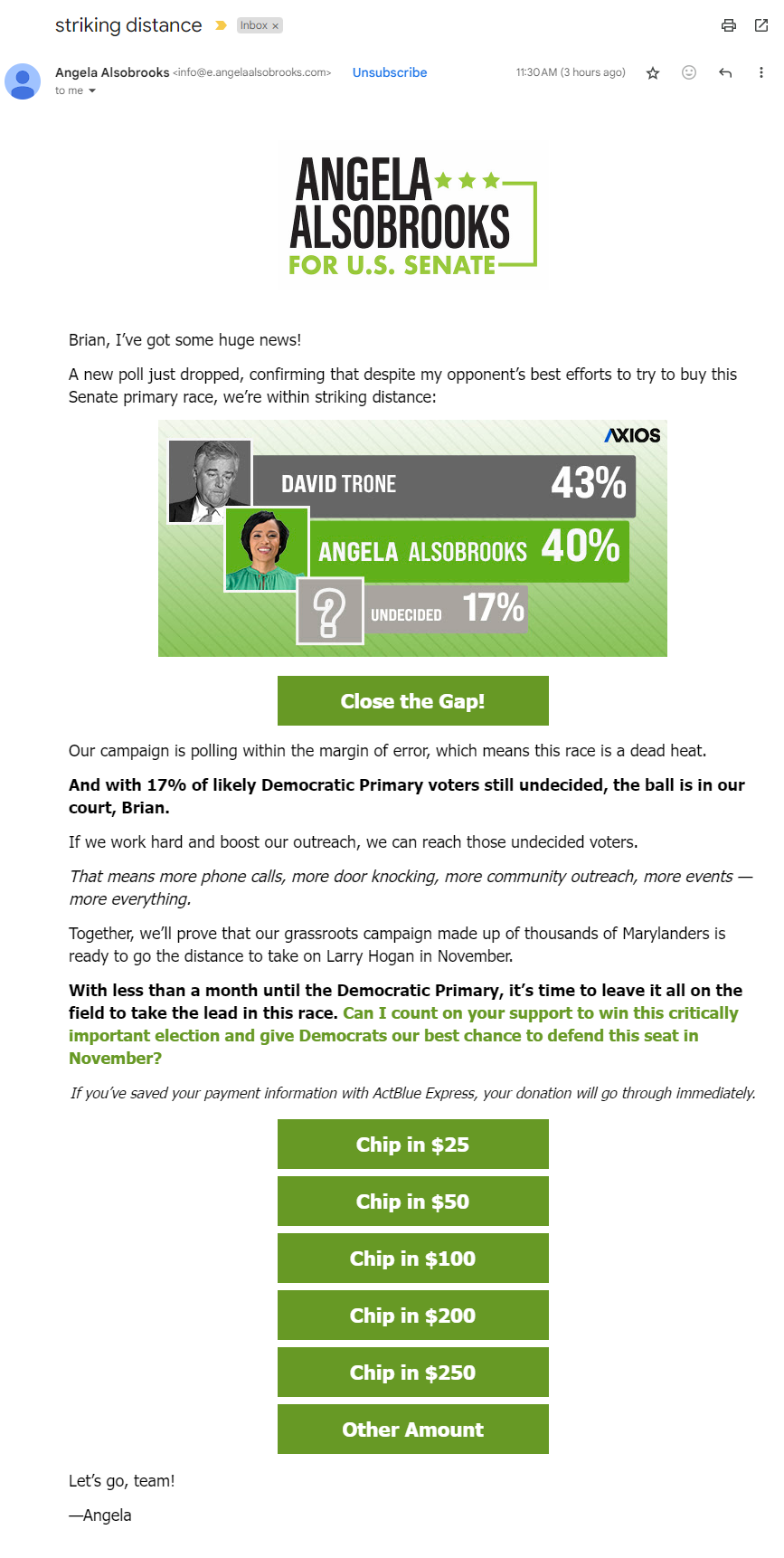
Except if you go to the Axios article that discussed the poll, within the article itself, its bylined author Stephen Neukam writes “Alsobrooks is within the margin of error against Trone, according to internal Alsobrooks campaign polling obtained by Axios.” Thus, compounding the misleading logo, the use of a ”a new poll” when the people writing this email were well aware that it was their own campaign’s commissioned poll is absolutely also a deliberate obfuscation, and, to make matters worse, the use of Axios’s logo on the graphic to mislead readers to clearly make them think the poll is by Axios when the campaign itself was the party responsible for providing its own poll directly to Axios even further compounds the sinning.
This trifecta of dishonesty is simply disgraceful and goes beyond anything near relatively acceptable so-called “spin;” rather, we have two examples if information being deliberately withheld from readers—that the poll was an internal Alsobrooks campaign poll and that the Alsobrooks campaign gave the results to Axios—and a full-on misrepresentation by putting the Axios logo on the poll graphic, giving the clear impression this misleading labeled “a new poll” is an Axios poll, all in order to confer fake legitimacy on the poll by making it appear it is not an internal poll and allowing the impression to be clearly conveyed to the reader that the poll is from the independent news outlet Axios.
The partisan internal poll as described by Axios highlights that Alsobrooks is at 40%, just 3 points behind Trone at 43% (with 17% undecided) and within the margin of error. There is also a third omission falling within the realm of normal spin: another poll—this one a far more credible, independent poll put together by The Baltimore Sun, Fox 45 Baltimore, and the University of Baltimore at just about the same time as the Alsobrooks campaign’s internal poll—had Alsbrooks 19 points behind Trone, 29% to 48%. Now, it’s normal for a campaign to highlight a more favorable poll even if also perhaps misleading in that that the poll the campaign chooses to highlight may be unrepresentative, but it is downright dishonest to tout your own internal campaign poll as “a new poll,” suggest visually that it is a poll from a major news outlet, and then omit that your own campaign fed the poll data to that news outlet: this is far from normal and should be called out as simply wrong.
Why is it important do sharply distinguish between internal polls and other polls? Let me explain if you’re not familiar with internal polls. Internal polls released by a campaign are self-selected datapoints and usually not the full or transparent set of data: the parts that are shared are deemed by the campaign to be favorable and are chosen to be shared with the public because the campaign thinks it will benefit in some way from the information being released. Most internal polls are not released and what is released tends to be the best possible tidbits among other tidbits and other internal polls that are not to selected to be released.
Furthermore, partisan internal polls average out to be significantly more favorable in their results towards their preferred candidate than independent polls not paid for by such a campaign and should, therefore, be taken with a full salt-shaker, not just a grain of salt even if they are not useless. Nate Silver’s FiveThirtyEight for some time banned the listing of internal polls on its site and later would actually show that it had adjusted internal polls by changing the results to account for that bias in favor of the candidate by reversing the bias away from the campaign’s preferred candidate. Simply put, internal partisan polls are generally less accurate and far less transparently disseminated to the public and generally should, as a result, be trusted far, far less than non-partisan independent polls. Thus, it is truly a sign of the desperation of the Alsobrooks campaign at this stage, about a month before the primary and about two weeks before early voting, that it released an internal poll still showing her down three points to Trone (accounting for the bias, this poll actually does not suggest she is close to Trone or really closing in, but those who don’t know about the bias of internal polls can be fooled by this presentation).
Considering all this, this play by the Alsobrooks campaign breaks major principles of honesty and attribution in attempting to pass off one of its own polls to readers as a “normal” “from” Axios poll in order to give the false impression that polling data has Alsobrooks in a close race with Trone. For the data absolutely does not show this: in four credible independent non-partisan polls beginning in February, Alsobrooks was down 15 (17% to 32%), then 7 (27% to 34%), then 9 (33% to 42%), and, most recently, 19 points (29% to 48%) to Trone. In this context, passing off an internal poll as having Alsobrooks down just 3 points (40% to 43%) as indicative is the overall state of the race is highly misleading.
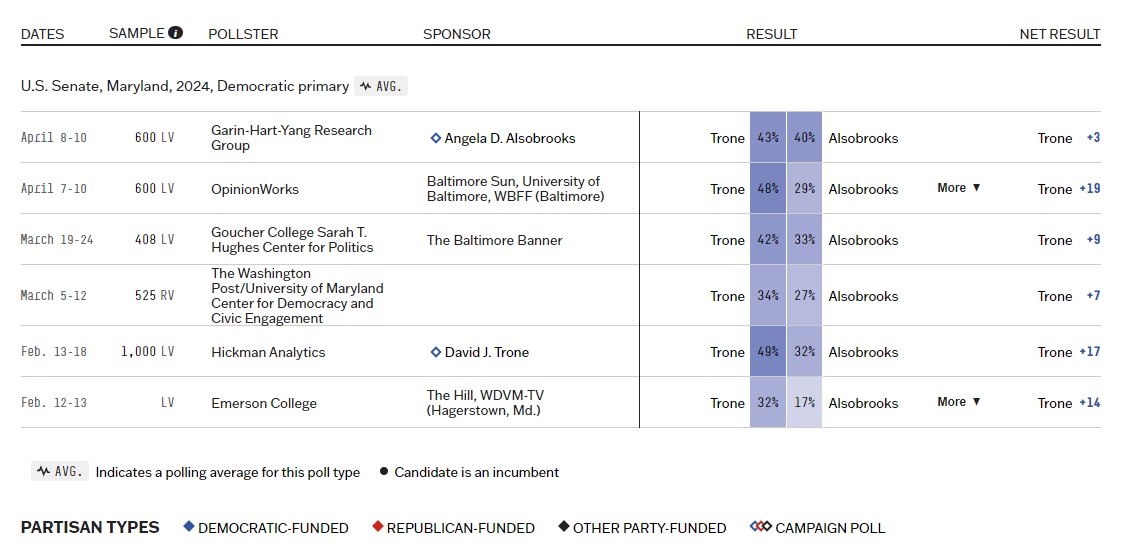
As noted, it falls within the normal realm of political spin and campaign advocacy to cherry-pick the best polling for your candidate and present that to voters while not stressing other less favorable polls. But this is not what the Alsobrooks campaign did with this e-mail to all of its followers: it presented its own internal poll as “a new poll”—not as its own internal poll—and presented it as an Axios poll and, on top of that, did that when the campaign itself had provided that data to Axios. This is a form of lying to voters and is disinformation: deliberate misrepresentation, misattribution, and omission to dupe voters into thinking its candidate is far more competitive than any of the credible data indicates.
But now we must also talk about journalistic integrity: the reporter, Stephen Neukam (I tried to contact him directly but received no response), and/or his editors at Axios were either engaging in blatant advocacy designed to unfairly boost (from a journalistic perspective) the Alsobrooks campaign or were not discerning or careful enough with their work to realize they were being coopted by the Alsobrooks campaign to push a misleading agenda about the state of the race, with Neukam’s article’s title being “Hot Dem primary in Maryland tightens a month before election;” to be fair, as a journalist myself I know that often we reporters are not the ones who craft the title and that editors often do that in ways me might not choose to for our own work, but the point is, Neukam or his editors or both did present a clearly misleading picture with that headline but also some of the text within the article by putting out an Alsobrooks campaign internal poll as evidence of a tightening Democratic U.S. Senate primary race between Trone and Alsobrooks when only that less credible internal poll deliberately provided to Axios by the Alsobrooks campaign presented such a picture and the other more credible independent, non-internal, non-partisan polls had shown Trone with a much larger lead: the latest poll with Trone leading Alsobrooks by 19 was just days away from coming out on April 16 when the Axios article was published on April 12, but the latest independent poll before that had come out on April 2 and gave Trone a 9-point lead, and, as noted, the other two previous polls had also given Trone a far larger lead than the 3-point lead of the Alsobrooks campaign internal poll.
Are we getting into the weeds here? Sure. But we reporters are like mechanics who are responsible for fine-tuning and checking out what’s under the hood for the customer. And what has happened here is that a used car salesman has lied about what he sold his customer or was not professional enough to know what he as a salesman picked up was not in good working order before selling it, either knowing the car was messed up or getting hoodwinked by the seller he got it from before selling to the customer. In this case, I am the mechanic, pointing out what is not working under the hood to the voters, raising questions about Axios and Neukam and clearly finding wrongdoing by the Alsobrooks campaign.
There have to be consequences and learning here. Both Neukam and Axios should review what happened and be careful in the future not to present any internal polls as game-changers or indicative or the real state of any race, especially one provided directly by that poll’s campaign to them; at best, such an internal poll should be an aside detail in a larger article, it should not drive a headline claiming to portray the state of a major high-stakes primary race: this is just good journalist practice to avoid overstating internal polls (and a single poll in general) and Axios needs to do better. And the Alsobrooks campaign should reprimand or perhaps even fire the staff responsible for framing that e-mail’s contents the way it was framed.
In the end, any political campaign must establish and preserve trust with its supporters (current or prospective), and a breach of that trust by deliberately feeding them disinformation about polling, the nature of the polling, and who produced the polling to paint an unrepresentative picture of the level its candidate’s competitiveness in order to paint a far more favorable picture for the candidate than the reality in order to, in turn, raise money from people reading that disinformation is a serious affair that is a test for the campaign and its integrity, its very ability to be honest even when the going gets tough.
As I stated in the beginning, I very much do not believe County Executive Alsobrooks herself was personally involved in generating the disinformation in this e-mail, but the campaign does bear her name and she is responsible for the staff she and her senior staff select as well as all of the content put out by their campaign. So while I do not believe she would do anything like this, if nothing is done to correct this serious breach of trust exhibited by that email, if steps are not taken to prevent any reoccurrence of anything similar, it would call into question her ability to lead, to run a major political office, and to put people in place who will properly react to such breaches of trust when discovered. While I can understand the pressure in a race to raise money against a very wealthy opponent who has heavily outspent you when the real polling has you down significantly and the primary is just weeks away, there is no excuse for this behavior exhibited in this e-mail, nor for ignoring such behavior or letting it slide. Still, this is an opportunity for her and her campaign to show leadership by doing the right things, by issuing an apology and a correction and disciplining those responsible for the disinformation email discussed herein.
Alsobrooks Also Has Other Issues
Apart from the disinformation email, the Alsobrooks campaign can fairly be accused of being less than stellar in its approach. The e-mails you get from her campaign nearly all come off as if they are written by AI, lacking substance and pizazz, and nearly all asking for money and centering on asking for money, many of those complaining about how much money Trone has spent (and boy, we will get to that!).
Yes, Trone has spent a lot of money, but Alsobrooks has raised a lot, too: not that far from $7.2 million through the end of March, including $2.1 million for 2024’s first quarter. But you’d be hard-pressed to understand how that money has been spent. Is it on quality e-mail communications? Certainly not. It is on television ads? Nope: Alsobrooks has only just started putting out TV ads in mid-February (and not that many since then until the past few weeks). Which begs the question: why? Because she has significant amounts of money she is not spending. History tells us that striking first helps: you frame the race that way and put your opponent on the defensive, forcing him to react, while also raising your own profile earlier and generating more attention and thus drawing more money earlier: spending more early means you can raise even more later in a reinforcing feedback loop. And the March Washington Post/UMD poll had 58% of respondents saying they had “no opinion” when it came to Alsobrooks to 46% saying the same for Trone while Hogan had a 64% favorable rating.
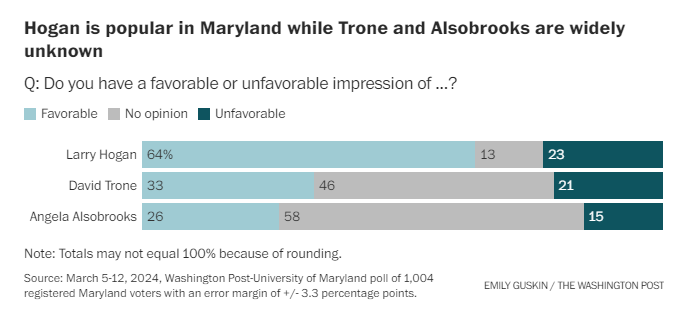
But even with her massive challenge with a clear majority of voters not knowing who she is or much about her, for Alsobrooks, of the more than $4.9 million she had raised by the end of 2023, over $3.1 million had remained unspent at that time (“cash on hand”). After the end of first quarter of 2024 just a few weeks ago, Alsobrooks had nearly $3.2 million cash on hand unspent and for the entire campaign, had spent less than $4 million; in contrast, Trone had spent nearly everything he had, with just under $1 million left unspent at the end of March and spending over $41.6 million by then.
Folks, this represents two very different strategies. Trone’s is to leave it all on the field and to be the one who shapes the race and garners notice and recognition (much) sooner rather than later, but it is not clear what Alsobrooks’s own strategy is: people are already voting by mail and early voting starts May 2, in ten days. What is she waiting for??
If Alsobrooks loses, her people will claim it is because she was so heavily outspent. But that will not necessarily be the reason why as more money doesn’t always mean victory. In U.S. Senate general election races, the bigger spender has lost in about one-fifth of the races in the past two decades. And at the presidential level, Bernie Sanders outspent Hillary Clinton in 2016 and lost while she outspent future insurrectionist Donald Trump in the general election and lost; Biden was outspent in 2020 by Bernie and some other rival Democrats, too, all who lost; and Trump was outspent by some of his rivals in the 2016 primaries (remember Jeb! and his $100 million?) who lost and has been outspent by some of his 2024 primary opponents.
Again, I don’t know what Alsobrooks is spending her campaign’s money on, but her TV ads starting so late in the primary may have doomed her campaign, especially seeing how many ads with which Trone was flooding the market. She should have been advertising on TV towards the end of 2023 and she had the money then to have done so, which would almost certainly have garnered her more name recognition and then more money and more support. We will never know if it would have been enough, but the Alsobrooks campaign has hardly been running an A-game campaign that looks capable of upsetting a higher-spending rival: a much-better-run campaign can beat and has beaten a less-well-run campaign even if that less-well-run campaign outspends it, but if you aren’t even running a particularly good campaign, money is hardly the beginning or the end of your woes or the clear reason for a loss, for which it looks as if Alsobrooks is heading.
Alsobrooks has also had a harder time explaining how her experience as a county executive and state’s attorney translates well into the work of the Senate, while Trone’s efforts in the House translate perfectly to Senate work as they are both concerning federal legislative positions. As I have discussed before, this is in part because voters have long-deemed county executive work to be less relevant and less transferable when it comes to the U.S. Senate, only exceedingly rarely sending someone in that position directly to the U.S. Senate. Additionally, while Alsobrooks has touted specific accomplishments as a county executive, it is unclear what distinguishes her from other country executives in terms of her record: sharing a debate stage with her four times, I have not heard rank her accomplishments relative to other county executives in the state or make an evidence-based case that sets her apart from other county executives in general, whereas Trone is quick to tout that he is one of the most objectively bipartisan members of Congress and the most effective of the entire Maryland delegation. Thus, Trone sounds more like a senator that she does talking about what he does as a leader and has been more effective in explaining what makes him unique and stand out among his peers.
Additionally, Trone has also garnered an impressive number of endorsements from prominent Democrats in Alsobrooks’s own Prince George’s County as well as U.S. House Minority Leader (and hopefully soon-to-be-Speaker) Hakeem Jeffries, an African-American and one of the country’s most prominent and powerful black politicians in a race where Alsobrooks is definitely highlighting the historic nature of her candidacy as an African-American woman.
Furthermore, while I have seen Trone generate a more dynamic response from audiences with a somewhat more energetic and dynamic style, Alsobrooks is more reserved and careful with her approach. I experienced this most keenly observing the two at a NAACP forum last month in front of a mostly-African-American church audience in Fort Washington. I was a bit surprised that Trone seemed to connect more viscerally with that audience than Alsobrooks, who by no means did poorly but was not having the same dynamic effect as Trone was. So cautious and reserved can be a good strategy if you have a large lead, but reserved and careful is not a good strategy when you are down significantly and consistently in the polls. In particular, the Alsobrooks campaign keeps projecting an “everything is fine” vibe even as she has consistently polled significantly behind Trone and has always polled worse against Hogan than Trone (her best number against Hogan—40% to Hogan’s 44%–came from the March Goucher College poll, which had a significantly smaller sample size than the other independent polls and is likely less accurate as a result), continuing as they have without making any major adjustments since he entered the race. Echoing my sentiment, the main Baltimore Sun reporter covering this race, Jeff Barker, yesterday came out with an article titled “Alsobrooks isn’t running as if she’s behind in Maryland’s US Senate primary.” So others are also perplexed by this approach besides me…
And while I am certainly aware of gender and race dynamics—it is easier for a white man than a black women to speak more openly and worry less about consequences—the difference is still there and everything can matter and come under scrutiny for any candidate in a high-profile contest like this one. Also, in general, her staff members at these events have seem more protective and hovering than those of Trone. I admit these are anecdotal observations, but Alsobrooks seems great as a person and shouldn’t be seen as needing protection in a race like this by her staff but even more exposure.
To conclude, I am not sure who is helping Alsobrooks make these calls, but it sure does not seem as if her senior staff have served her well. As a significant underdog to Trone as far as polling and money, waiting to spend millions and adopting a more reserved and careful approach is not a path to victory. Getting the twin powerhouse endorsements of rockstar Maryland U.S. House Representative Jamie Raskin and The Washington Post—Trone would certainly have liked to have received either or both and they should persuade some undecideds—perhaps they think those endorsements will be enough to close the gap along with increased spending on ads late in the game, but that may very well be overly optimistic and is likely downright risky, given the size of the gap between her and Trone indicated in credible polling (that latest Sun/Fox/UB disastrous-for-Alsobrooks poll with her down 19 came weeks after Raskin’s endorsement but before the Post’s), and Trone is sure to surge more of his own money into advertising these last few weeks, too.
Trone’s Mortifying Polling vs. Hogan in the Context of Record Spending
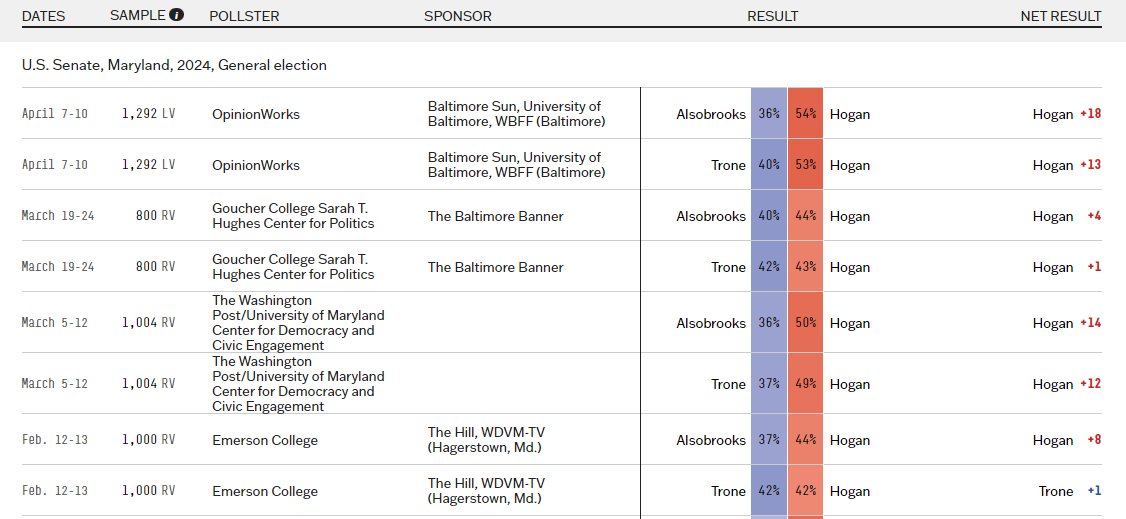
In case you thought I was going to let Trone off easy or was even endorsing him here, this section will make it clear I am not. Trone has put a staggering amount of his own family fortune into this race: some $41.7 million. If this sounds like a lot, it is: it’s the largest amount a self-funder has ever poured into a U.S. Senate primary in American history, with the next highest person and amount not even reaching $30 million. And while he seems to have a comfortable lead over Alsobrooks and would be the favorite to win the primary at this point, his numbers for a possible matchup against Hogan, while better than Alsobrooks’s, have ranged from troublesome to dismal: the first independent credible poll in February had him tied (42%-42% vs. an 8-point deficit for Alsobrooks), then he was down 12 (49%-37% vs. a 14-point deficit for Alsobrooks), then down one in that likely-less-accurate Goucher poll with the smaller sample size (42%-43% vs. a 4-poit deficit for Alsobrooks), then down 13 points (40%-53% vs. an 18-point deficit for Alsobrooks). For both candidates, these are terrible numbers in a very blue state against a Republican in the era of Trump, and while Alsobrooks has spent far less and is a county executive as opposed to a member of Congress, meaning lower name recognition is more of an excuse for her, for Trone and the nearly $42 million spent through up through the first quarter, this is a terrible result: even flooding the airwaves in the most recent polls has him either trailing in heavily-Democratic Maryland or losing by double digits, the latest poll having him down 13 points. With all the money spent, I worry this suggests Trone has more of a ceiling relative to Alsobrooks, but that may not be the case. But I do worry that after so many commercials (if you watch non-streaming-service TV, you must have seen his ads and likely a lot), there could be a sizable chunk of voters that are more than a little hesitant to back him in the general election.
And while Alsobrooks has incessantly criticized his level of self-funding in a rather classist manner I have criticized before (in contrast to his hollow attacks on her as a “career politician”), strategically-minded Democrats like myself and some party leaders welcome the idea that during a general election, national Democratic Party efforts and the efforts of liberal allies and big leftist donors can count on Trone self-funding and turn their money and attention to other competitive races across the country. But many other voters will not be thinking about that, and while I have mentioned that Alsobrooks is not the most dynamic or energetic speaker, I do worry that Trone being easily stereotyped as an old rich white guy will not help generate enough enthusiasm, especially compared to the idea of the much younger African-American female candidate in Alsobrooks. Then again, enthusiasm isn’t everything, lots of less-enthusiastic people still vote and Trone so far has consistently been ahead of Alsobrook while also doing better against Hogan, even if he still loses to him. In this case, time will tell and I am honestly torn at this point as to who is the better candidate against Hogan, as is much of the rest of the Maryland electorate.
Speaking of Trone having a more dynamic, freewheeling, colorful style than Alsobrooks, while often an asset, this also can lead to him making gaffes that Alsobrooks would not make. One example of this was at the aforementioned NAACP forum, when he said he we need to “beat Larry Hogan like a rented mule” (this drew laughs but also groans and a mild, playful rebuke from the moderator; if there were PETA or vegetarian/vegan folks in the audience, that sure did not help Trone with them). Another gaffe was at a House hearing last month in which Trone quite seemingly inadvertently substituted an old racial slur for the word “bugaboo,” a mishap that generated negative coverage nationwide and outrage on Twitter but might not have done too much damage.
Interestingly, of the six Maryland U.S. House Democrats who are not David Trone, five have endorsed Alsobrooks to just one of Trone’s Maryland Democratic U.S. House colleagues endorsing him, while Maryland’s Governor Wes Moore and Maryland’s other U.S. Senator besides Cardin, Chris Van Hollen, have also endorsed Alsobrooks.
Conclusion: It’s Late in the Game but We Need These Candidates Need to Do Better or We Need Someone Else (ME!)
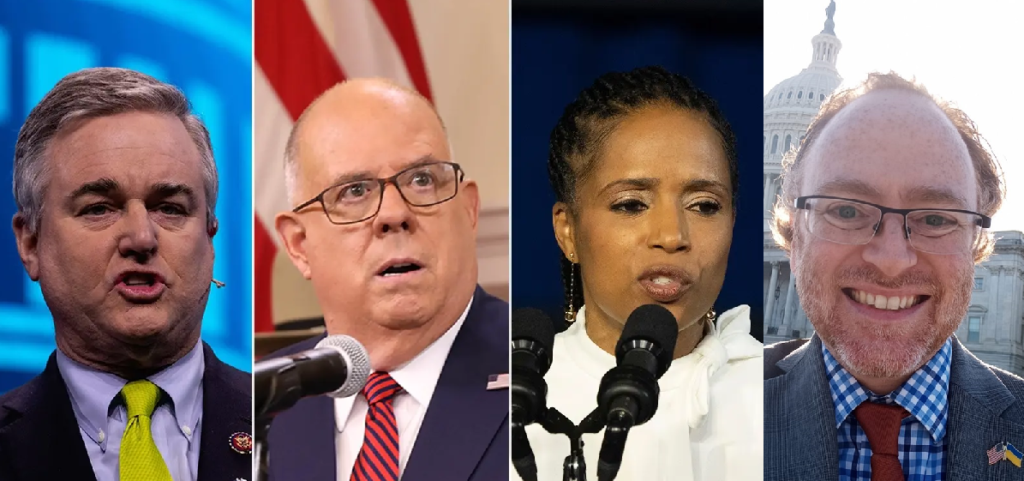
Even after my first debate with Trone and Alsobrooks (and the only one on which I shared the stage with Trone as he did not attend the next three while Alsobrooks did), it was clear that the performances I saw from both, while ok, were not stellar and not anything that would make me feel particularly confident in either debating Hogan (not that that they were bad, but when you are down a lot to an opponent, you have to be able to clearly beat them in several areas and debates are one of those key areas). I am just worried that neither are particularly strong against Hogan and the polling we have thus far with neither beating him in a very Democratic state suggests my worries and those of others are justified.
Sure, polls can change over time. It’s possible for Alsobrooks to overcome her deficit with Trone, and it’s possible for either to overcome their deficits against Hogan. But that is not guaranteed, they do not seem to be on the path to a general election victory now, and it’s going to be too close for comfort in a state where a Democrat should easily win. And that is, simply put, because we do not have better candidates. The frontrunners’ current approach—that they are projecting confidence against Hogan without making any serious adjustments since he entered the race even after polling consistently shows them not beating him—is not reassuring.
Because of these campaigns’ complacency and the lack of journalists trying to push them on why they are polling so badly against Hogan in a blue state, I think it is necessary for someone else to be a third person in the weeks we have left in this race to draw attention to these issues and their shortcomings and to perhaps present a third alternative voters can rally behind. I think I am the only Democratic candidate who can do this: the other candidates I shared space with on four debate stages so far totally avoided these issues, could not provide answers of any depth on a number of pressing topics (in contrast see me answering in the debates here and I even outshone the only frontrunner who attended in one of the debates!), and did not garner anywhere near the media coverage I have: I am the only candidate besides Trone or Alsobrooks still in the race to be quoted by any major news outlets, including The Washington Post and The Baltimore Sun (see details of my coverage here). I am likely third in the sense that I have a far greater presence on social media than any of the candidates (close to more than the Trone and Alsobrooks campaigns combined on Twitter) and more news media mentions than any other second-tier candidate, so I will come up far more easily and quickly for voters searching for information about other candidates, and once they get to my site, they will see I have by far the most detailed policy proposals of any candidate. So for all those reasons, I believe I am likely to come in third but I need your help to really make a statement and make sure the frontrunners get the message that they need to do better!!
Look, I am not going to mislead any of you by inflating my chances of outright winning this race: I have not polled above 1% yet (technically 1.2% *but see April 30 update above that discusses rounding in polling), and it is far more likely that I can be that voice that helps hone the candidates and their campaigns and push them to adjust to be in a better position against Hogan than it is likely that I would actually win the nomination (though stranger things and political miracles have happened). Maybe if I finish third on an upcoming poll, I can leverage that to be on stage with Trone and Alsobrooks in an upcoming debate (there’s only been one televised debate so far and just this past Friday—which only has about 4,200 views on YouTube—pretty ridiculous!) but I need you help for any of this to happen.
If I finish a strong third set firmly apart from all the other candidates after Trone and Alsobrooks, I think I can make that case publicly more effectively and perhaps even garner more influence on the party nominee and his or her campaign during the general election. If you are concerned about what I have discussed here or are hesitant at all about the frontrunners, vote for me to let them know they need to step up their game and change course to earn your general election vote.
In the Democratic presidential primary, voters voting “uncommitted” to protest the Biden Administrations policies on Israel and Palestine amidst the Gaza war have been heard and acknowledged by Biden and his people in tense and difficult circumstances, and I have long-argued that Biden is already shifting policy in major ways behind the scenes to stand up more for Palestinians that are not yet apparent to most under a horrific geopolitical setting, but the point is that movements aiming to have a symbolic affect in political primaries can affect the conversation and garner attention at the highest levels.
We need better from Trone and Alsobrooks if one will be our standard bearer to keep Cardin’s seat blue for Democrats to better fight Trumpist MAGA insurrectionist fascism and I can play role in making that happen and, though it’s a longshot, maybe a political miracle can happen and I will be your nominee. Whatever the outcome, whether the nominee is Trone, Alsobrooks or myself—and I will support whomever the nominee is enthusiastically—supporting me will help Democrats’ odds of winning in November because a bubble mentality and complacency is the path to losing in November. Hogan may not be Trumpist, insurrectionist, or fascist, but he will vote far too much with MAGA so we have to win in November!
Bubbles in politics are nothing new and are quite common, but are not only dangerous in people governing but also with more extremist segments among the population. They are also dangerous in campaigns, and the lack of self-awareness emanating from the two main frontrunners’ campaigns in the Maryland U.S. Senate Democratic primary should give all Marylanders and Americans united against insurrectionist Trump’s MAGA fascist extremism great cause for concern. We need these candidates and their senior staff who think everything is going just fine and no major adjustments are needed to get out of their bubbles and I am the only candidate who seems willing to push them in this direction. Spread the word and donate so we can put Democrats in the best possible chance to keep Cardin’s seat blue and defeat Hogan this fall to fight MAGA in the Senate!
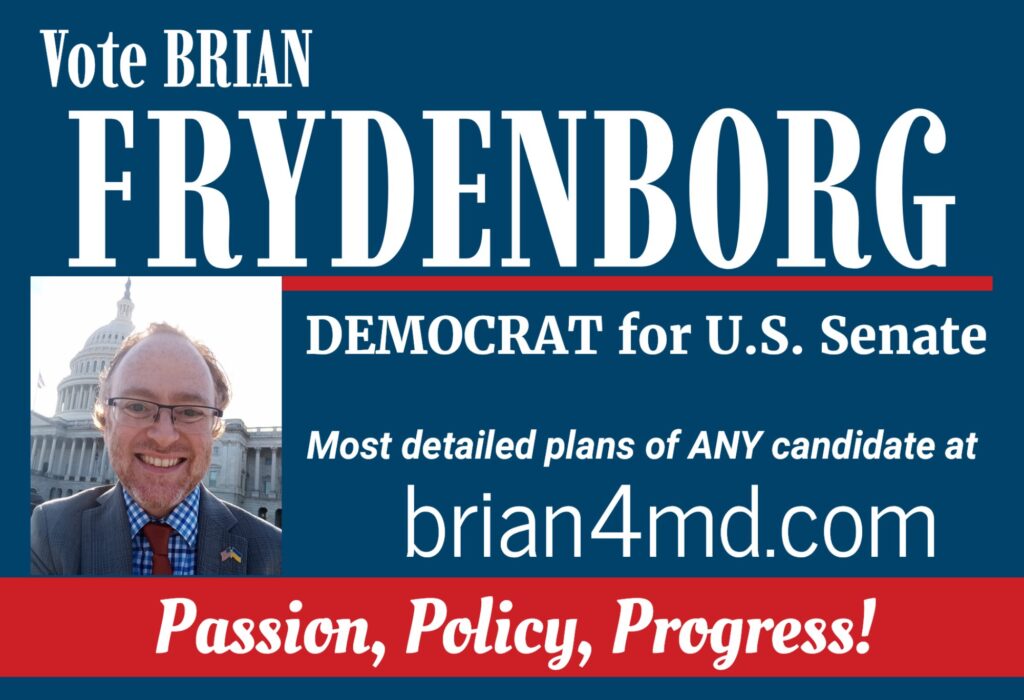
See related articles Frydenborg Holds His Own Against Alsobrooks in Baltimore Maryland U.S. Senate Democratic Primary Debate, but Will It Matter & Why Won’t Local Media Cover this Race Properly?, Maryland U.S. Democratic Primary Debate Raises Questions on Frontrunners’ & Party’s Readiness to Take on Hogan. Can Frydenborg Emerge As Third Option? and Petty Feuding Between Trone and Alsobrooks Does Not Honor Ben Cardin’s Legacy. Vote for Me Instead! And see all of Brian’s Maryland U.S. Senate race coverage here as well as Brian’s official campaign website.
© 2024 Brian E. Frydenborg all rights reserved, permission required for republication, attributed quotations welcome
Also see Brian’s eBook, A Song of Gas and Politics: How Ukraine Is at the Center of Trump-Russia, or, Ukrainegate: A “New” Phase in the Trump-Russia Saga Made from Recycled Materials, available for Amazon Kindle and Barnes & Noble Nook (preview here).

If you appreciate Brian’s unique content, you can support him and his work by donating here; because of YOU, Real Context News surpassed one million content views on January 1, 2023. Real Context News produces commissioned content for clients upon request at its discretion.
Feel free to share and repost this article on LinkedIn, Facebook, Threads, and Twitter. If you think your site or another would be a good place for this or would like to have Brian generate content for you, your site, or your organization, please do not hesitate to reach out to him!